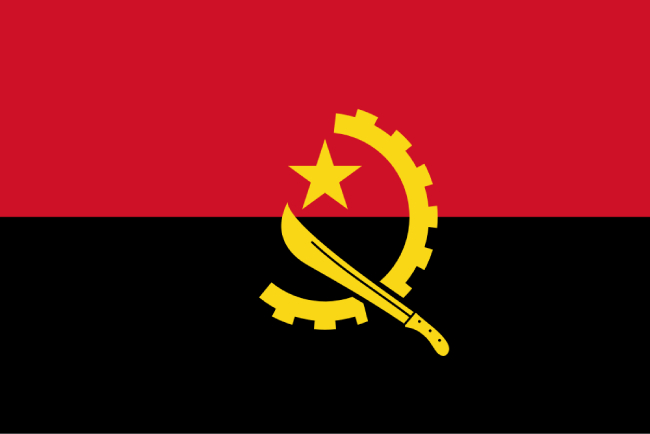Angola is a country on the western coast of southern Africa. Angola is bordered by the Atlantic Ocean in west, Namibia in south, the Democratic Republic of the Congo (former Zaire) in north, and Zambia in the east. The exclave province of Cabinda is separated from Angola by a tongue of the Democratic Republic of the Congo and has also borders with the Republic of the Congo.
Angola occupies an area of 1,246,700 km², compared it is almost 14 times the size of Portugal, the former colonial power of the country, or slightly less than twice the size of the U.S. state of Texas.
Angola has a population of 24.4 million people (census 2014). Largest city and the national capital is Luanda. Spoken languages are Portuguese (official), and several Bantu languages like Kikongo, Kimbundo, Tchokwe, Umbundo and others.
Background at Angola
Civil war has been the norm in Angola since independence from Portugal in 1975. A 1994 peace accord between the government and the National Union for the Total Independence of Angola (UNITA) provided for the integration of former UNITA insurgents into the government and armed forces.
A national unity government was installed in April of 1997, but serious fighting resumed in late 1998, rendering hundreds of thousands of people homeless. Up to 1.5 million lives may have been lost in fighting over the past quarter century. The death of Jonas Savimbi and a cease fire with UNITA may bode well for the country.
President Dos Santos (in office since 1979) pushed through a new constitution in 2010 and elections held in 2012 saw him installed again as president. Angola assumed a nonpermanent seat on the UN Security Council for the 2015-16 term.
In an article from March 2015, the New York Times wrote:
“This is a country laden with oil, diamonds, Porsche-driving millionaires and toddlers starving to death. New Unicef figures show this well-off but corrupt African nation is ranked No. 1 in the world in the rate at which children die before the age of five.”
Business & Economy in Angola
Angola’s high growth rate in recent years was driven by high international prices for its oil.
Angola became a member of OPEC in late 2006. Oil production and its supporting activities
contribute about 85% of GDP and diamond exports contribute an additional 5%.
Subsistence agriculture provides the main livelihood for most of the people, but half of the
country’s food is still imported. Despite a postwar reconstruction boom, much of the country’s infrastructure is still damaged or undeveloped from the 27-year-long civil war.
Geography of Angola
Location: Southern Africa, between Namibia and Democratic Republic of the Congo.
Area: 1,246,700 km² (481 400 sq. mi)
Terrain: A narrow, dry coastal strip extending from Luanda to Namibia; well-watered agricultural highlands; savanna in the far east and south; rain forest in the north and Cabinda.
Climate: Semiarid in south and along the coast; north has a cool, dry season (May – October) and a hot, rainy season (November – April)
People of Angola
Nationality: Angolan(s).
Population: 24,4 million (2014)
GNI Per Capita PPP: $6,484 (year)
Ethnic Groups: Ovimbundu 37%, Kimbundu 25%, Bakongo 13%, mixed racial 2%.
Languages: Portuguese (official), Ovimbundu, Kimbundu, Bakongo, and others.
Religions: Christians 88%, indigenous beliefs.
Literacy: 70% (male 82%, female 58%).
Natural Resources of Angola
Petroleum, diamonds, iron ore, phosphates, copper, feldspar, gold, bauxite, uranium.
Agricultural Products of Angola
Bananas, sugarcane, coffee, sisal, corn, cotton, manioc (tapioca), tobacco, vegetables, plantains; livestock; forest products; fish.
Industries in Angola
Petroleum; diamonds, iron ore, phosphates, feldspar, bauxite, uranium, and gold;
cement; basic metal products; fish processing; food processing; brewing; tobacco products; sugar; textiles.
Exports – Commodities in Angola
Crude oil, diamonds, refined petroleum products, minerals, coffee, sisal,
fish and fish products, timber, cotton.
Exports Partners of Angola
China 43.8%, India 9.6%, US 7.7%, Spain 6.2%, South Africa 4.8%, France 4.4%
(2015)
Imports – Commodities in Angola
Machinery and electrical equipment, vehicles and spare parts; medicines, food, textiles, military goods.
Imports – Partners of Angola
China 22.1%, Portugal 13.8%, South Korea 11%, US 6.9%, South Africa 5%, UK 4.1%, France 4% (2015)
Currency of Angola
Kwanza (AOA)
CENTER FOR AFRICAN STUDIES
Center for Africa Studies (AFRAM) which located in Ankara, is an organization facilitating under the administration of African Affairs Council (AFAC). It makes various researches about Africa to enhance economic and cultural bounds between Africa and Turkey. AFRAM’s publishings has been shared with different institutions as they require to obtain.
AFRICA OBSERVATORY
Africa Observatory is one the publishing of AFRAM and it has been published each two weeks. It has been delivered to different institutions via e-mail.






